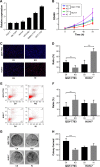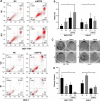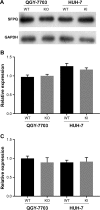NEAT1_2-SFPQ axis mediates cisplatin resistance in liver cancer cells in vitro
- PMID: 30254462
- PMCID: PMC6140748
- DOI: 10.2147/OTT.S163774
NEAT1_2-SFPQ axis mediates cisplatin resistance in liver cancer cells in vitro
Abstract
Background: Liver cancer is a type of malignant tumor with high morbidity and mortality in People's Republic of China. Its occurrence and development involve the variation and expression changes of multiple genes, and the pathogenesis and related regulatory networks are complex.
Purpose: In the present research, we investigate the involvement of NEAT1_2 and SFPQ in cisplatin resistance in liver cancer. The effects of LncRNA NEAT1 and SFPQ expression on the chemotherapeutic resistance of liver cancer cells were analyzed.
Methods: The expression level of NEAT1_2 and SFPQ mRNA in tissue specimens or cell lines were examined by RT-qPCR and western blotting. CCK-8 assay was performed to evaluate cell viability. Cell proliferation was performed using the EdU cell proliferation assay.
Results: Our data showed that increase NEAT1_2 and SFPQ expressions in liver cancer specimens were associated with the development of cisplatin resistance; high SFPQ expression level impaired patients' survival from liver cancer. Gain-and loss-of function assay using NEAT1_2 knock-in and knock-out cells constructed using CRISPER/Cas9 system revealed that NEAT1_2 is essential for liver cancer cell survival and mediates cisplatin resistance in liver cancer cells at least partially through SFPQ. Artificial change in NEAT1_2 expression level didn't significantly influence SFPQ transcription or translation level.
Conclusion: Our data revealed NEAT1_2-SFPQ axis as a novel cisplatin resistance mechanism in liver cancer cells in vitro.
Keywords: NEAT1; NEAT1_1; NEAT1_2; SFPQ; cisplatin resistance; liver cancer.
Conflict of interest statement
Disclosure The authors report no conflicts of interest in this work.
Figures




Similar articles
-
LncRNA NEAT1 Recruits SFPQ to Regulate MITF Splicing and Control RPE Cell Proliferation.Invest Ophthalmol Vis Sci. 2021 Nov 1;62(14):18. doi: 10.1167/iovs.62.14.18. Invest Ophthalmol Vis Sci. 2021. PMID: 34787639 Free PMC article.
-
LncRNA NEAT1 enhances the resistance of anaplastic thyroid carcinoma cells to cisplatin by sponging miR‑9‑5p and regulating SPAG9 expression.Int J Oncol. 2019 Nov;55(5):988-1002. doi: 10.3892/ijo.2019.4868. Epub 2019 Sep 4. Int J Oncol. 2019. PMID: 31485599 Free PMC article.
-
lncRNA NEAT1 regulates gastric carcinoma cell proliferation, invasion and apoptosis via the miR‑500a‑3p/XBP‑1 axis.Mol Med Rep. 2021 Jul;24(1):503. doi: 10.3892/mmr.2021.12142. Epub 2021 May 13. Mol Med Rep. 2021. PMID: 33982777 Free PMC article.
-
The c-Myc-regulated lncRNA NEAT1 and paraspeckles modulate imatinib-induced apoptosis in CML cells.Mol Cancer. 2018 Aug 28;17(1):130. doi: 10.1186/s12943-018-0884-z. Mol Cancer. 2018. PMID: 30153828 Free PMC article.
-
[SFPQ and NONO Proteins and Long Non-Coding NEAT1 RNA: Cellular Functions and Role in the HIV-1 Life Cycle].Mol Biol (Mosk). 2022 Mar-Apr;56(2):259-274. doi: 10.31857/S0026898422020161. Mol Biol (Mosk). 2022. PMID: 35403619 Review. Russian.
Cited by
-
Combination of levofloxacin and cisplatin enhances anticancer efficacy via co-regulation of eight cancer-associated genes.Discov Oncol. 2022 Aug 19;13(1):76. doi: 10.1007/s12672-022-00541-x. Discov Oncol. 2022. PMID: 35984577 Free PMC article.
-
CRISPR/Cas9 system: a novel approach to overcome chemotherapy and radiotherapy resistance in cancer.Naunyn Schmiedebergs Arch Pharmacol. 2025 Apr;398(4):3373-3408. doi: 10.1007/s00210-024-03480-2. Epub 2024 Nov 19. Naunyn Schmiedebergs Arch Pharmacol. 2025. PMID: 39560750 Review.
-
Dysregulation of RNA splicing in early non-alcoholic fatty liver disease through hepatocellular carcinoma.Sci Rep. 2024 Jan 30;14(1):2500. doi: 10.1038/s41598-024-52237-7. Sci Rep. 2024. PMID: 38291075 Free PMC article.
-
A New Understanding of Long Non-Coding RNA in Hepatocellular Carcinoma-From m6A Modification to Blood Biomarkers.Cells. 2023 Sep 14;12(18):2272. doi: 10.3390/cells12182272. Cells. 2023. PMID: 37759495 Free PMC article. Review.
-
LncRNA nuclear-enriched abundant transcript 1 shuttled by prostate cancer cells-secreted exosomes initiates osteoblastic phenotypes in the bone metastatic microenvironment via miR-205-5p/runt-related transcription factor 2/splicing factor proline- and glutamine-rich/polypyrimidine tract-binding protein 2 axis.Clin Transl Med. 2021 Aug;11(8):e493. doi: 10.1002/ctm2.493. Clin Transl Med. 2021. PMID: 34459124 Free PMC article.
References
-
- Chen W, Zheng R, Zhang S, et al. Cancer incidence and mortality in China, 2013. Cancer Lett. 2017;401:63–71. - PubMed
-
- Llovet JM, Bruix J. Systematic review of randomized trials for unresectable hepatocellular carcinoma: Chemoembolization improves survival. Hepatology. 2003;37(2):429–442. - PubMed
-
- Martin LP, Hamilton TC, Schilder RJ. Platinum resistance: the role of DNA repair pathways. Clin Cancer Res. 2008;14(5):1291–1295. - PubMed
-
- Bowden NA. Nucleotide excision repair: why is it not used to predict response to platinum-based chemotherapy? Cancer Lett. 2014;346(2):163–171. - PubMed
LinkOut - more resources
Full Text Sources
Other Literature Sources

